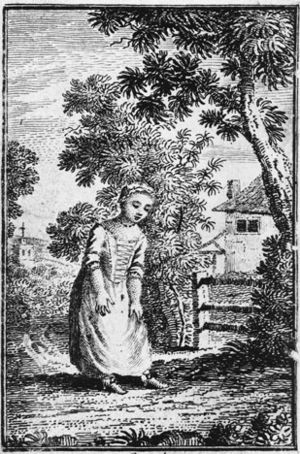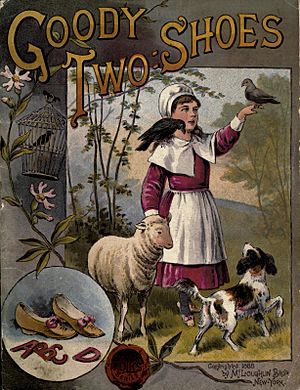The History of Little Goody Two-Shoes facts for kids
The History of Little Goody Two-Shoes is a famous children's story. It was first published in London in 1765 by John Newbery. This book helped make the phrase "goody two-shoes" popular. Today, we use this phrase to describe someone who is always trying to be good or do the right thing, sometimes a little too much!
Contents
What the Story is About
The story of Goody Two-Shoes is a bit like the Cinderella tale. It's about a poor orphan girl named Margery Meanwell. She was so poor that she only had one shoe. People started calling her "Goody Two-Shoes" as a nickname.
One day, a kind, rich gentleman gave her a brand new pair of shoes. Margery was so incredibly happy! She ran around telling everyone she met, "I have two shoes! I have two shoes!"
Later in life, Margery became a teacher. She was very good at it and helped many children learn. Eventually, she married a rich man who had lost his wife. This part of the story showed that her kindness and good deeds were rewarded. This idea, that good people get good things, was a very common message in children's books back then.
How the Book Was Published

The person who wrote Goody Two-Shoes is not known for sure. It was published in London by the John Newbery company. This company was famous for publishing many popular children's books.
The book became very popular very quickly. It was printed many times in both England and America. Even though it was sometimes changed a bit by different publishers, it remained a favorite for a long time.
Who Wrote the Story?
Many people believe that the Irish writer Oliver Goldsmith wrote Goody Two-Shoes. He often wrote stories for money and was known for his playful writing style. Some people, like the writer Washington Irving, thought it sounded just like Goldsmith's work. However, others think that John Newbery himself, or his friend Giles Jones, might have written it. We may never know for sure!
Where the Phrase "Goody Two-Shoes" Came From
The book The History of Little Goody Two-Shoes definitely made the phrase "goody two-shoes" well-known. But the phrase might have been around even before the book was published!
For example, the phrase appeared about 100 years earlier in a poem from 1670 by Charles Cotton. In that poem, the name "Goody Two-shoes" was used to point out that someone was privileged or had more than others. "Goody" was a common way to say "Mrs." back then. So, "Goody Two-shoes" was like saying "Mrs. Two-shoes," comparing her to people who didn't even have one shoe.


